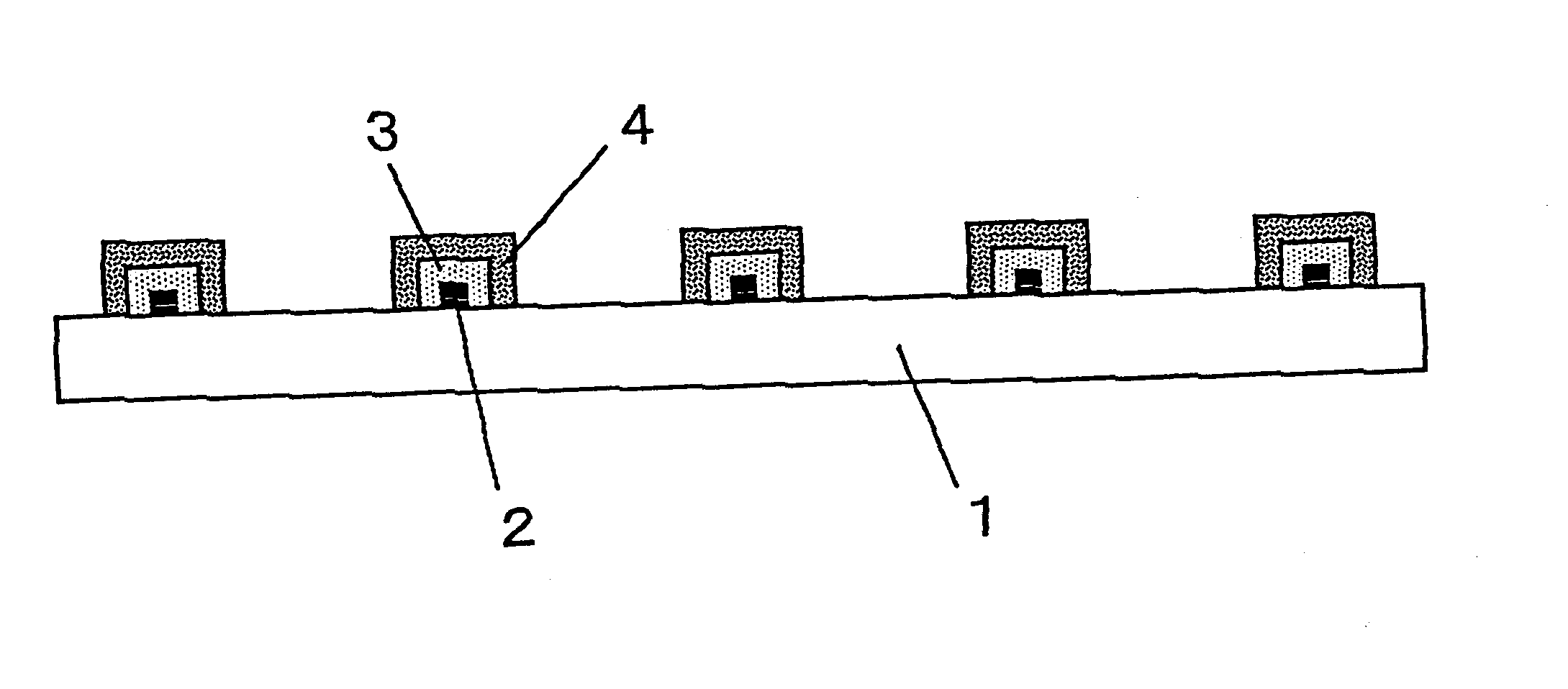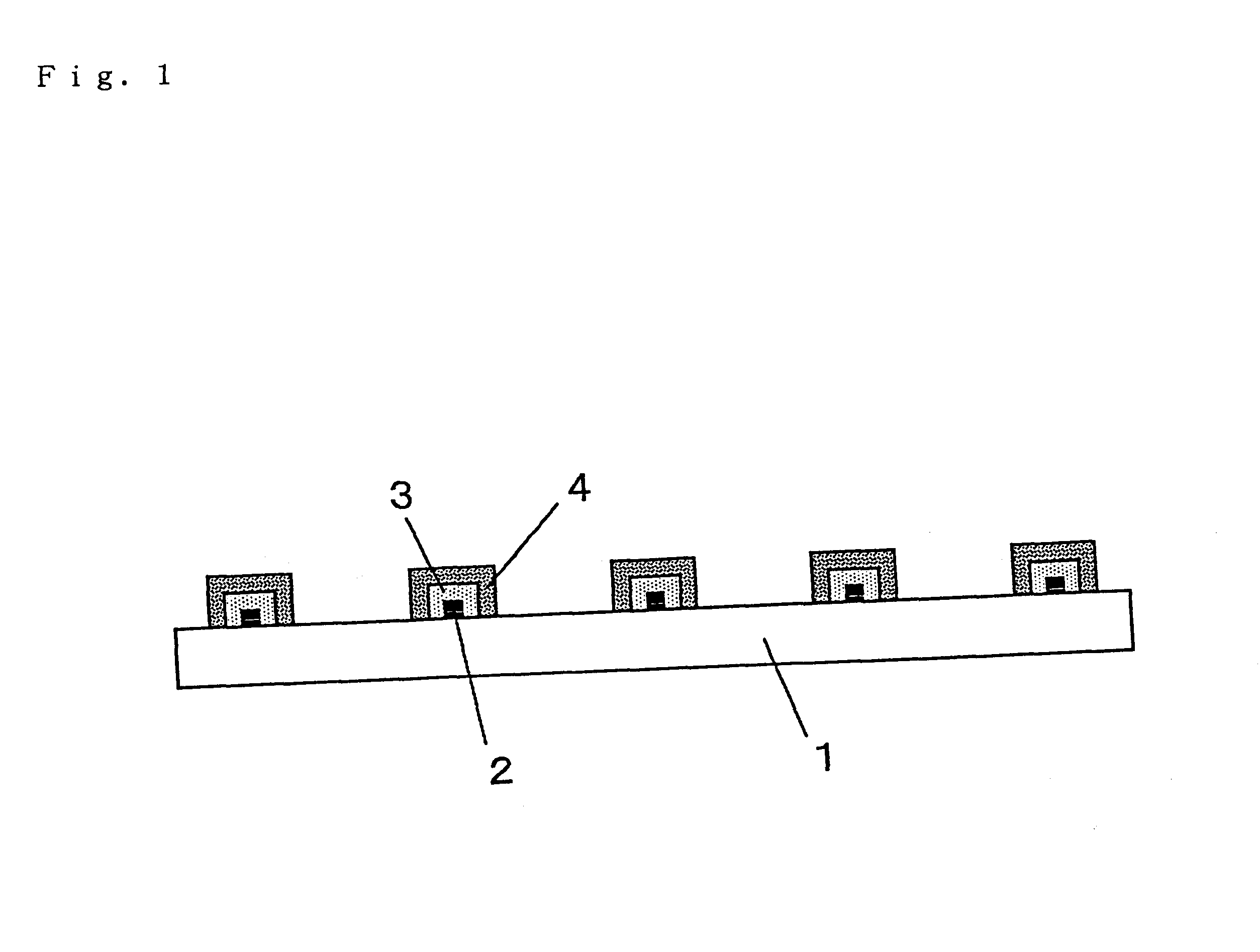Electromagnetic shielding plate and method for producing the same
a technology shielding plate, which is applied in the field of electromagnetic shielding plate, can solve the problems of easy expansion and contraction of the mesh, and increased difficulty in handling the mesh
- Summary
- Abstract
- Description
- Claims
- Application Information
AI Technical Summary
Benefits of technology
Problems solved by technology
Method used
Image
Examples
example 1
On a soda-lime glass substrate having a size of 300 mm.times.400 mm and a thickness of 3 mm, a lattice-form pattern having a line distance of 250 .mu.m and a line width of 27 .mu.m was formed with Paste A by a plate offset printing process.
The glass substrate carrying the printed pattern was baked in an air at 700.degree. C. for 5 minutes, and then quenched by blowing the air. With such treatments, the pattern was firmly adhered to the substrate, and the substrate glass was tempered.
The polyester resin contained in Past A alone was subjected to a thermogravimetry by heating the resin at 700.degree. C. for 5 minutes. These heating conditions are comparable to the baking conditions above. The polyester resin was burnt out almost completely.
The tempered glass substrate carrying the baked pattern was degreased by dipping it in a 50 g / L solution of a degreasing agent ("ACE CLEAN A-220" manufactured by Okuno Chemical Co., Ltd.) kept at 50.degree. C. for 10 minutes, and then dipped in a 10...
example 2
A pattern was formed on a glass substrate by a plate offset printing process, and then the pattern was baked and the glass substrate was tempered in the same manners as in Example 1 except that Paste B was used in place of Paste A. The ethylcellulose resin contained in Paste B alone was subjected to a thermogravimetry by heating the resin at 700.degree. C. for 5 minutes. The ethylcellulose resin was burnt out almost completely.
Thereafter, the substrate carrying the formed pattern was subjected to the electroless plating with copper, the electroplating with copper and anodization in the same manners as those in Example 1 to make the surface of the pattern black.
The results of the evaluations of this electromagnetic shielding plate are shown in Table 1.
example 3
A pattern was formed on a glass substrate by a plate offset printing process in the same manner as in Example 1 except that Paste C was used in place of Paste A. Then, the pattern was baked at 450.degree. C. for 1 hour. The polyester resin contained in Paste C alone was subjected to a thermogravimetry by heating the resin at 450.degree. C. for 5 minutes. The residual amount of the polyester resin after baking was 5% of the weight of the resin before baking.
Thereafter, the substrate carrying the formed pattern was subjected to the electroless plating with copper, the electroplating with copper and anodization in the same manners as those in Example 1 to make the surface of the pattern black.
The results of the evaluations of this electromagnetic shielding plate are shown in Table 1.
The electromagnetic shielding property of the electromagnetic shielding plate was evaluated. The results are 53 dB at 50 MHz, 53 dB at 100 MHz, and 60 dB at 300 MHz.
PUM
| Property | Measurement | Unit |
|---|---|---|
| softening point | aaaaa | aaaaa |
| width | aaaaa | aaaaa |
| softening point | aaaaa | aaaaa |
Abstract
Description
Claims
Application Information
 Login to View More
Login to View More - R&D
- Intellectual Property
- Life Sciences
- Materials
- Tech Scout
- Unparalleled Data Quality
- Higher Quality Content
- 60% Fewer Hallucinations
Browse by: Latest US Patents, China's latest patents, Technical Efficacy Thesaurus, Application Domain, Technology Topic, Popular Technical Reports.
© 2025 PatSnap. All rights reserved.Legal|Privacy policy|Modern Slavery Act Transparency Statement|Sitemap|About US| Contact US: help@patsnap.com


